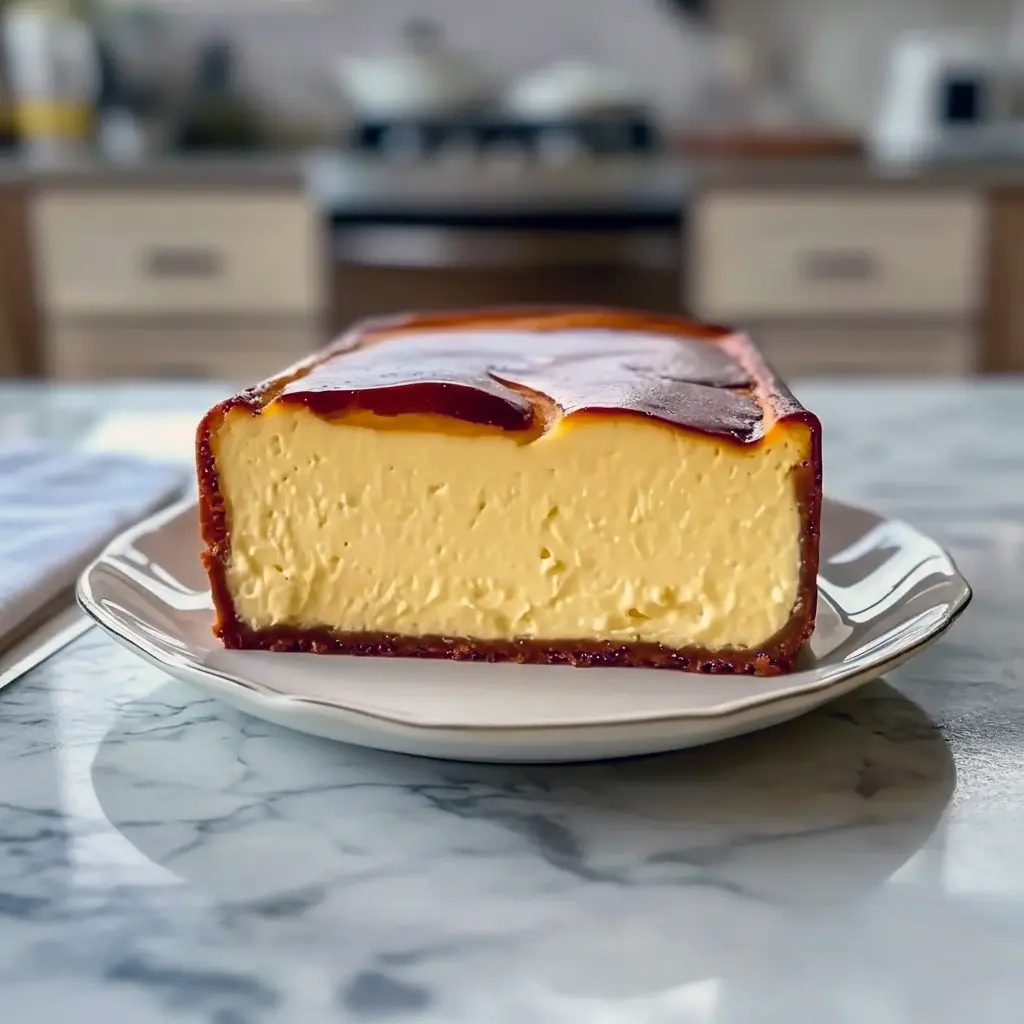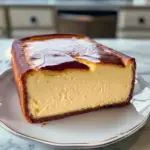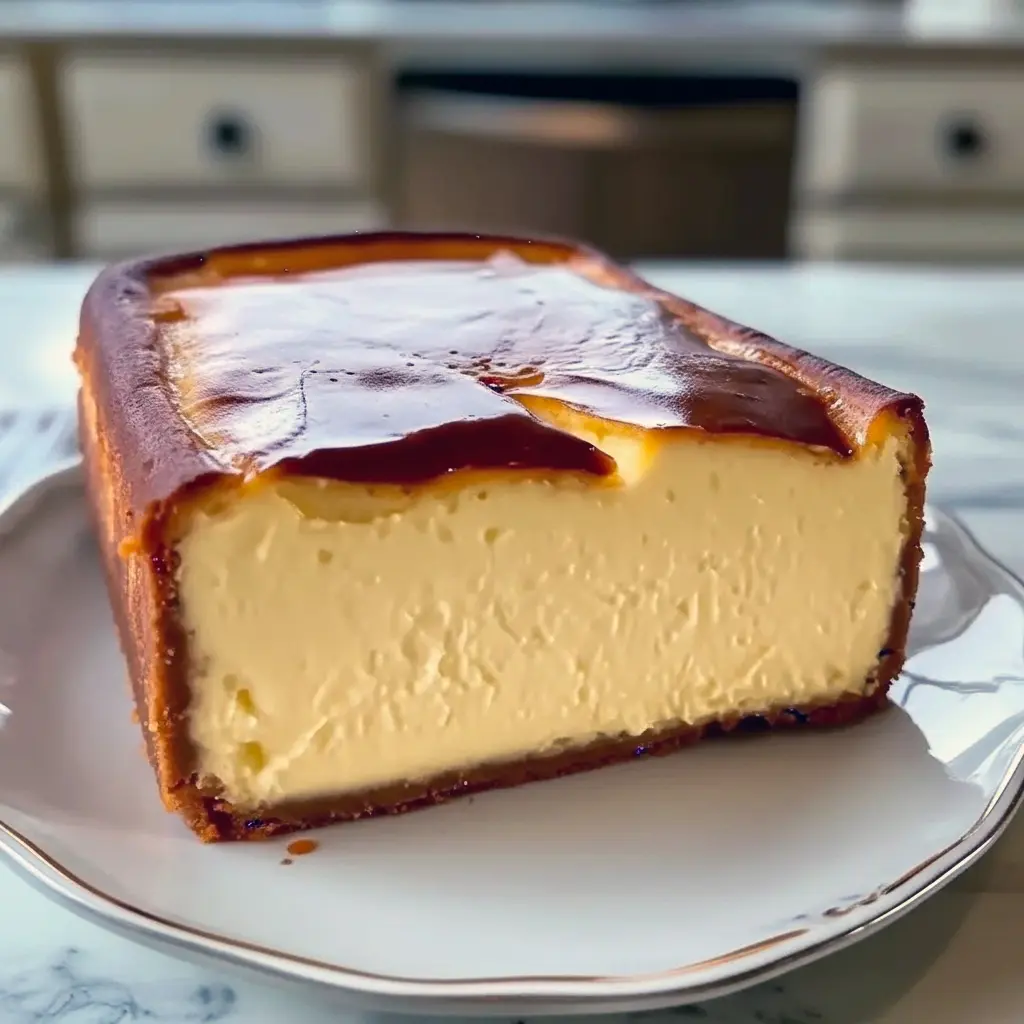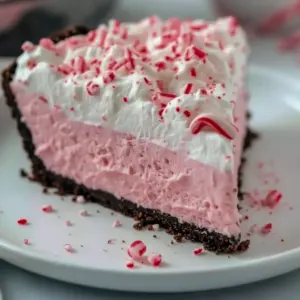Basque Cheesecake Loaf Pan gives you that rustic, caramelized top and custardy center in a loaf — no fancy water bath, no drama, just insane flavor and silky texture from a handful of simple ingredients.
Introduction — what this loaf is and why you’ll want it
Want a dessert that looks fancy but bakes like a no-fuss champ? This Basque-style cheesecake in a loaf pan nails it. It builds on the beloved Cheesecake Desserts tradition: scorched, almost-burnt top, ultra-creamy interior, and a wildly easy technique. Slice it thick, serve it neat, or go wild with berries — either way, people will think you slaved over it. Spoiler: you didn’t.
What makes this loaf so irresistible?
Why does Basque cheesecake get so much love? Two words: contrast and texture. The high oven heat gives you a bitter-sweet, caramelized exterior that plays perfectly against the custardy, mildly sweet interior. The result tastes complex but requires almost no elbow grease. Also: it’s a loaf. That means clean slices, easy storage, and perfect portions for brunch or parties. Want to impress with minimal fuss? This is your no-brainer.
Bold tip: Use room-temperature cream cheese and beat until perfectly smooth — lumps ruin the silk.
Ingredients — what you need and why it matters
- 24 oz (680 g) full-fat cream cheese, softened — the backbone of the custard.
- 1 cup (200 g) granulated sugar — sweetens and helps with browning.
- 4 large eggs — set the custard and give it body.
- 1 cup (240 ml) heavy cream — for that dreamy, silky mouthfeel.
- 1 tsp vanilla extract — rounds flavor (or use vanilla bean paste).
- 2 tbsp all-purpose flour — stabilizes without weighing the custard down.
- 1/4 tsp salt — balances sweetness and highlights nuance.
Short notes: full-fat dairy makes the texture lush; flour helps prevent a totally runny center; salt is non-negotiable. If you’re feeling nutty, add a few tablespoons of almond meal for a mild almond note (hello, Almond Recipes territory).
Simple method — step-by-step (no water bath, no stress)
- Preheat oven to 425°F (220°C). Line a 9×5-inch loaf pan with parchment, letting paper extend well above the rim — crumple it a bit so it hugs the pan and creates rustic folds. Bold tip: Generous parchment is crucial for that signature wrinkled look and easy removal.
- Cream the cheese. Beat softened cream cheese in a large bowl until ultra-smooth (3–5 minutes). Scrape the bowl. No lumps allowed.
- Add sugar slowly. Gradually add sugar, beating until light and somewhat fluffy — about 2–3 minutes.
- One egg at a time. Add eggs one at a time, mixing until each is incorporated. Keep speed moderate to avoid whipping in too much air. Less air = fewer cracks.
- Cream and vanilla. Pour in heavy cream and vanilla; mix on low until combined.
- Fold flour and salt. Sift flour and salt over the batter and gently fold with a spatula until you see no streaks. Stop once combined.
- Pour and bake. Pour batter into prepared pan. Bake 50–60 minutes until the top is deeply browned and the center still jiggles (internal temp ~150–160°F / 65–71°C). High heat = burnt top + custard center.
- Cool slowly. Turn off oven, crack door, and let pan sit inside ~1 hour. This gentle cooldown reduces cracking. Then chill in fridge 4+ hours or overnight.
- Unmold & slice. Lift by parchment, slice with a sharp knife, and serve chilled or at room temp.
The story behind this loaf
Basque cheesecake started as a humble, rustic treat in Spain’s Basque Country. Bakers baked at high heat until the top charred and the middle stayed creamy — the so-called “burnt” look that actually makes the flavor. Translating that into a loaf pan keeps the personality but makes slicing easier. Think of it as Basque tradition meets modern loaf-pan practicality — same soul, simpler form.
Pro tips for flawless results
- Room-temp everything. Cold cream cheese or eggs = lumps and uneven texture.
- Don’t overbeat after eggs. Overmixing = air pockets = puffing and collapse. Mix until just mixed.
- Use high heat. That burnt top develops only at high temps — don’t be timid.
- Line generously. Wrinkled, high parchment = classic rustic look and easy removal.
- Chill fully. The cheesecake needs time to set. Overnight = cleaner slices.
- Keep watch. Ovens vary; check on the 45-minute mark. You want dark top, not charred to ash.
Bold tip: If the top looks too pale, give it a few more minutes. If it’s screaming burnt, tent foil for a few minutes — but don’t panic over a little darkness; it’s supposed to be intense.
Variations to try — play with flavors
- Almond-scented: Replace 1 tbsp flour with almond meal and add ½ tsp almond extract — great for Almond Recipes lovers.
- Citrus zing: Fold in 1 tsp lemon or orange zest for a bright finish.
- Chocolate swirl: Melt 2 oz dark chocolate, drop spoonfuls into batter, and swirl before baking.
- Cookie-bottom loaf: Add crushed Biscoff or graham cracker crumbs to the bottom for extra texture (borderline Bread Recipes Sweet territory).
- Boozy boost: Add 1–2 tbsp of Amaretto or Marsala for an adult twist.
Best way to serve — pairing and presentation
Serve slices chilled or slightly warmed to room temp. Top ideas: a light dusting of powdered sugar, a spoonful of mascarpone, fresh berries, a drizzle of honey, or even a scoop of vanilla gelato. Want to make breakfast feel decadent? Serve thin slices alongside coffee — it works as a luxe Breakfast Dessert or weekend treat.
Bold note: This loaf plays well with both sweet and savory pairings — try it with crushed toasted almonds or fresh figs.

Quick tips for storage & leftovers
- Refrigerate wrapped or in an airtight container for up to 5 days.
- Freeze slices individually on a tray, then bag for up to 3 months. Thaw overnight in the fridge.
- Re-crisp top? Torch sugar lightly on top for a brûlée effect before serving. (Yes, you can torch straight from the fridge.)
FAQs — quick answers
Will the “burnt” top be bitter?
It tastes pleasantly caramelized — slightly bitter notes balance the sweet, creamy center.
Do I need a water bath?
Nope — this method avoids the water bath. High, dry heat creates the Basque signature.
Why did my center collapse?
Too much air in batter or overbaking can cause major collapse. Mix gently and watch bake time.
Can I halve this for a smaller loaf?
Yes — use a smaller loaf pan and reduce baking time. Start checking 10–15 minutes earlier.
Can I make this in a springform?
Sure — a springform yields a traditional round Basque cheesecake if you prefer.
Troubleshooting — fixes for common issues
- Lumpy batter: Bring cream cheese to room temp and beat thoroughly before adding sugar.
- Too pale top: Oven not hot enough—increase heat or move pan higher.
- Overbrowned edges, raw center: Oven hot spots — rotate pan or lower temp slightly and bake longer.
- Excessive cracking: Cool gradually in the oven with door ajar to prevent thermal shock.
Why this recipe belongs on your menu
This loaf ticks a lot of boxes: easy technique, dramatic result, and ultimate satisfaction. It fits Just Desserts moments when you want to show off but don’t want to fuss. Slice it for brunch, pack it for a party, or serve a dramatic slice at the end of a dinner. It’s simple but feels elevated — the kind of Cooking Recipes Desserts winner that becomes a go-to.
Have you ever wanted to Eat Dessert First? This loaf will make you seriously tempted. Want to serve dessert at breakfast? Say yes to Eat Dessert mornings with a slice alongside espresso.
Final thoughts — a decadent, no-fuss showstopper
The Basque Cheesecake Loaf Pan proves that rustic elegance doesn’t demand hours or intimidation. With a few careful steps — room-temp cheese, gentle mixing, high heat, and patient chilling — you get a stunning loaf with a scorched, flavor-packed top and a melt-in-your-mouth interior. It’s modern comfort meeting old-world charm.
Whether you call it a showy Cheesecake Recipes centerpiece, a weekend Breakfast Dessert treat, or a loaf-sized entry into the world of Bread Recipes Sweet, this Basque loaf will earn applause. It’s a baker’s paradox: minimal technique, maximum reward. So preheat that oven, line your pan tall with parchment, and enjoy making something that tastes far more complicated than it actually is.
Bold takeaway: Room-temp ingredients + high heat + thorough chill = Basque perfection. Now go bake one and impress everyone (or just yourself).
Follow me on Pinterest for daily new recipes.
Print
Basque Cheesecake Loaf Pan — Rustic Cheesecake Desserts to Impress
- Prep Time: 20 minutes
- Cook Time: 50 minutes
- Total Time: 1 hour 10 minutes
- Yield: 10 slices 1x
- Category: Dessert
Description
A silky, ultra-rich Basque-style cheesecake baked in a loaf pan. No crust, a deeply caramelized (almost “burnt”) top, and a custardy, slightly wobbly center—sliced straight from the pan.
Ingredients
- 24 oz (680 g) full-fat cream cheese, softened to room temperature
- 1 cup (200 g) granulated sugar
- 4 large eggs
- 1 cup (240 ml) heavy cream
- 1 tsp vanilla extract
- 2 Tbsp (16 g) all-purpose flour
- ¼ tsp fine salt
Instructions
- Preheat your oven to 425°F (220°C). Line a 9×5-inch loaf pan with parchment, letting the paper rise several inches above the rim and crumpling it slightly so it sits naturally in the pan.
- In a roomy mixing bowl, beat the softened cream cheese with an electric mixer on medium speed until utterly smooth—about 3–5 minutes. Scrape the sides and bottom of the bowl a few times to ensure no lumps remain.
- Add the sugar gradually while mixing, continuing until the mixture lightens and becomes silky, another 2–3 minutes.
- Add the eggs one by one, mixing briefly after each until incorporated. Keep the speed moderate and stop as soon as each egg disappears into the batter—overbeating will whip in too much air.
- Pour in the heavy cream and vanilla and mix on low until the mixture is uniform.
- Sift the flour and salt over the batter and fold them in gently with a spatula until no dry streaks remain. Avoid vigorous stirring.
- Transfer the batter into the prepared loaf pan and smooth the top.
- Bake 50–60 minutes, or until the surface is deeply browned and almost blackened in spots while the center still trembles slightly when shaken. The internal temperature should be roughly 150–160°F (65–71°C).
- Turn off the oven, crack the door, and let the pan sit inside for about 1 hour to cool slowly.
- Remove the loaf and let it come fully to room temperature. Cover loosely and chill in the refrigerator for at least 4 hours or, ideally, overnight to finish setting.
- Use the parchment overhang to lift the cheesecake from the pan, slice with a sharp knife, and serve chilled or at room temperature.
Notes
- Soft cream cheese matters. Bring the blocks to room temperature so they blend totally smooth.
- Avoid overmixing. Gentle combining after the eggs keeps the texture custardy rather than rubbery.
- High oven heat creates the signature top. Don’t be alarmed by a very dark surface—this is classic Basque character.
- Generous parchment = easy removal. Let it extend well above the pan for simple lifting and for those attractive rustic folds.
- Chill fully. The flavor and texture improve after several hours in the fridge—overnight is best.
- Adjust baking time if needed. Oven performance varies; watch for the deeply browned top and a jiggly center.
- Flavor variations: Stir in a tablespoon of citrus zest, a pinch of cinnamon, or a splash of liqueur for a twist.
- Store refrigerated for up to 5 days. For longer storage, wrap slices and freeze; thaw overnight in the fridge before serving. Enjoy a slice plain, with berries, a drizzle of honey, or a small scoop of ice cream for extra indulgence.



